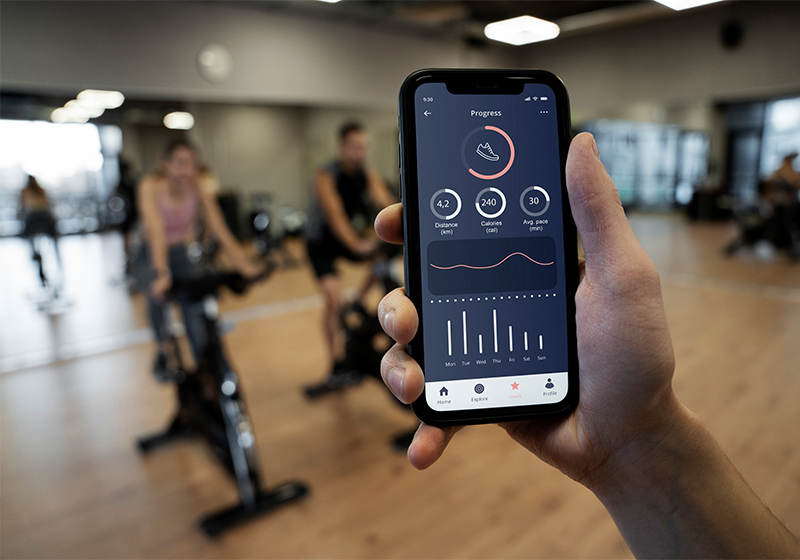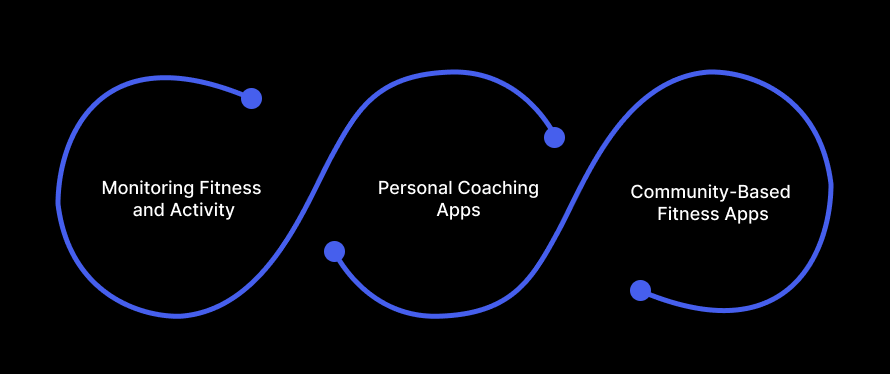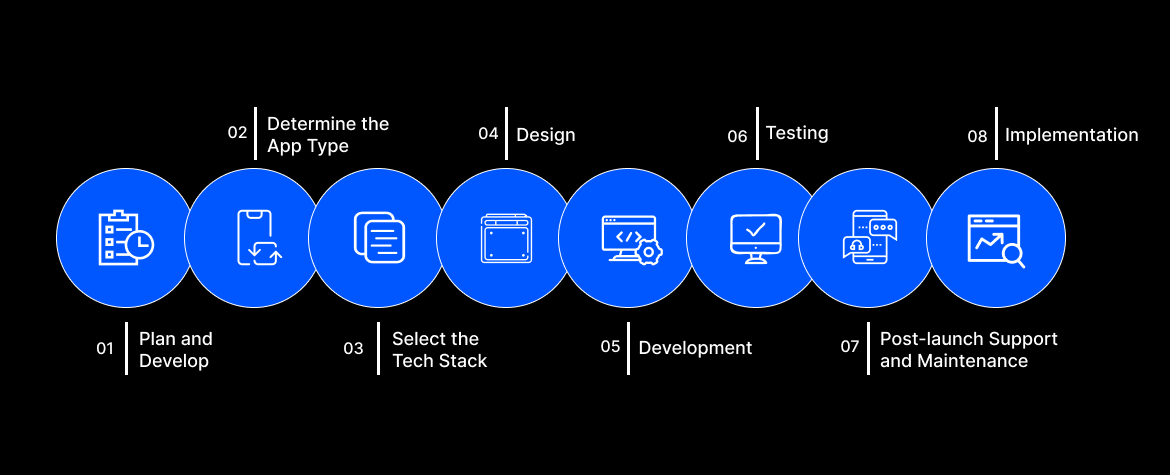Fitness App Development
How To Create Fitness App: A Step-by-step Guide
 Updated 25 Jul 2024
Updated 25 Jul 2024

Health and fitness have always been everyone’s main goals. Unfortunately, it was harder to keep fashionable and active back then as it was hard to locate fitness instructors you liked training with. Thankfully, the fitness sector has fully experienced a digital transition since the beginning of the digital era. Since then, a range of strategies have been designed in the creation of health and fitness apps, from encouraging good diets to providing users with one-tap workouts for weight reduction on smartphones.
Here, we will discuss step-by-step instructions for fitness app development as well as information about the newest features. But let’s start by discussing the basics.
The History and Evolution of Fitness Apps
The rise of fitness and health apps is an intriguing tale, considering its origins and current achievements. For a considerable period, the main innovation in the fitness industry was the availability of pre-made home workout videos that people could utilize for in-home training. People knew of only two options: using these or physically visiting a gym. Back then, desktop applications and fitness websites were popular as another cutting-edge method.
However, in the 2010s, a brand-new instrument emerged that gave every market and industry limitless opportunities. Since applications were valuable technology, businesses rushed to adopt them as one of the most successful ways to market their products and services. For example, social networking sites all made the quick decision to switch to applications. And because of the apps’ exceptional accessibility and adaptability, it was only a matter of time before they attracted millions of followers.
Apps provided an exciting opportunity for many businesses to flourish, find a distinctive way to brand themselves, and enter the fiercely competitive app market, which was somewhat of a lifeline for the fitness and health sector. Fitness apps had a modest beginning because of their constrained feature set. Only running trackers and basic exercise libraries were available in the applications store. Nike was one of the first apps available and quickly gained popularity.
Fitness apps evolved as apps expanded and added new features and functions. They began to add more features, integrations, original graphics, and other elements. Also, new types of fitness apps that addressed a wider range of health and fitness issues began to appear.
Custom Fitness Software Solutions: The Emergence of Personalized Fitness Software
As time went on, more people expressed interest in utilizing fitness applications. People’s interest in this increased when they were forced to rely solely on fitness applications in order to maintain their physical fitness. One of the most challenging periods in contemporary human history begins in the early 2020. People had to halt all activities due to the pandemic and quarantine temporarily. Still, some things can’t be put on hold for too long, like exercise and health. The idea of deploying personalized fitness applications first surfaced at this point. Due to its more sophisticated and individualized features, people began creating and utilizing personalized fitness applications. Custom fitness software solutions were able to focus on a particular aspect of fitness and adjust features and functionality appropriately, enabling users to find what they needed. Developing a fitness app with Q3 Technologies gives companies countless chances to take advantage of this and the way technology is revolutionizing the health and wellness sector.
The following project reports on fitness apps demonstrate the growing impact of digital fitness platforms such as fitness apps:
- The United States is driving the revolution in digital fitness. Eight of the top ten apps by customer spending in 2022 were US-based, with MyFitnessPal, Fitbit, and Calm ranking first through third.
- Customers are embracing gym apps, with almost 70% of them seeing them as a fun addition to their in-person workouts.
- Users are also being encouraged to venture beyond their comfort zones by the virtual exercise landscape. More than one-third of customers have begun going to a live fitness class that they found online.
Types of Fitness Apps
It’s essential to comprehend the various types of fitness apps that people search for before delving into the different facets of fitness mobile app development. Apps for fitness and health usually concentrate on stress relief, workout regimens, diets, and nutrition. As a result, fitness apps can be created in several categories. Below is a synopsis of every possible kind of fitness app:

1. Monitoring Fitness and Activity
Activity and fitness tracking apps are the earliest and most popular kinds of personalized fitness apps. These all-inclusive applications come with everything needed for users to monitor their activities precisely. They typically sync with device features, such as GPS, to obtain comprehensive daily activity logs from users. They track parameters such as speed, distance traveled, calories expended, and others to give information about total physical activity.
2. Personal Coaching Apps
Personal coaching apps are the second category of fitness apps. As they offer a customized experience from beginning to end, personal coaching and training apps are the pinnacle of customized fitness applications. These applications offer remote, customized coaching services that include making an exercise plan just for you, giving nutritional guidance, and even setting up one-on-one meetings with a fitness coach.
3. Community-Based Fitness Apps
Community-based fitness apps are the final category of fitness apps. Finding a location where you may receive encouragement and support from other trainees who share your interests is pleasant, in addition to having access to a variety of fitness experiences, workouts, and other activities. And for that reason, the idea of fitness applications with a community focus is currently booming.
Fitness App Development Process: Step-by-Step Guide
The process of developing a fitness application is multi-step and requires thoughtful planning and smart execution at each stage. Constructing a scalable and prosperous fitness app requires an understanding of every phase of the app development process.

1. Plan and Develop
Outlining the goals, target market, and essential features of the app is the first and most crucial stage in developing bespoke fitness software. Think about whether you want your app to provide a full platform with a variety of features or concentrate on particular fitness activities (like running, yoga, or exercises).
In order to design the ideal app category, you must first assess market trends, spot any potential holes in the market, and prepare for necessary features like chatbots and push alerts.
2. Determine the App Type
Recognize the fitness objectives, inclinations, and challenges of your target market to determine the best type of fitness app. Selecting the appropriate category is essential for the success of any app, be it a virtual coach, community-based platform, nutrition tracker, or fitness planner.
3. Select the Tech Stack
The next crucial stage in creating a strong fitness app is integrating the appropriate technology, which comes after app type selection and conception. The choice of tech stack has a big impact on how much it costs to design a custom fitness app and how much functionality it can have.
4. Design
Developing an interesting and user-friendly app requires designing a visually appealing UI/UX. Creating visual components like color schemes, typography, and iconography that complement the app’s branding is part of this step. User testing and iterative design reviews aid in the design’s improvement and usability.
5. Development
The fitness app development company works to make your fitness app idea a reality during this step of the development process for health and fitness apps. Building the app’s front-end and back-end interface, as well as integrating the required third-party services and APIs, are all part of this stage. In order to encourage a better lifestyle, developers employ the appropriate programming languages and incorporate crucial features like user profiles, activity monitoring, workout regimens, revenue models, and nutrition logging, depending on the platform (iOS, Android, or cross-platform) that is chosen.
Q3 Technologies is a leading fitness mobile app development company offering scalable and safe fitness app development solutions. Our cutting-edge technologies, which include machine learning, data analytics, and AI in fitness apps, enable organizations to confidently and conveniently start their fitness app development journeys.
6. Testing
It is one of the most important stages before your product is ultimately released onto the intended platform. Defects, malfunctions, and flaws are found and fixed with the help of testing and quality control. The fitness app development company will perform manual testing in addition to automated testing with testing frameworks to make sure that the app functions properly across various screen sizes and operating systems.
7. Implementation
When testing is finished, and the software satisfies quality requirements, deployment can begin. At this point, the application is submitted in accordance with the specific rules and specifications of the intended stores, such as the Google Play Store and the Apple App Store.
8. Post-launch Support and Maintenance
For your health and wellness app to remain competitive after launch, ongoing assistance and maintenance are essential. During this phase, the app’s functionality is being tracked, user input is being addressed, bugs are being fixed, user data is being analyzed, and frequent updates are being released to either add new features or enhance current ones.
Businesses may produce a high-quality wellness app that satisfies user needs, encourages engagement, and accomplishes business goals by adhering to this step-by-step process for developing fitness apps.
Let’s Wrap Up
Its evident that the evolution of fitness apps has revolutionized the health and fitness industry, providing users with personalized, convenient, and engaging ways to stay active and healthy. By understanding the history, types, and development process of fitness apps, businesses can leverage these digital tools to meet the growing demand for innovative fitness solutions. Partnering with a proficient fitness app development company ensures the creation of high-quality, user-centric apps that drive engagement and achieve business goals. As technology continues to advance, the future of fitness apps looks promising, offering endless possibilities for enhancing user experiences and promoting overall well-being.
Build a Secure and Scalable Fitness App with Q3 Technologies
Our scalable architecture, best undustry practices, and user-centric design approach guarantee that your fitness software not only meets but surpasses the expectations of contemporary users. We have successfully delivered projects for global clients such as Samsung, Compass Group, Havells, WHO, KPMG, Adani Electricity, MedAdvisor, Jewelex, American Tower, and many others.
Partnering with Q3 Technologies ensures the creation of high-quality, user-centric apps that drive engagement and achieve business goals. Contact Q3 Technologies today to start developing your custom fitness app and stay ahead in the competitive fitness industry.
Explore More

Software Development
Healthcare Software Development—Key Features, Trends, and Cost

Mobile Applications
Mobile Apps in Healthcare: Driving Patient Engagement and Accessibility

Mobility Solutions
